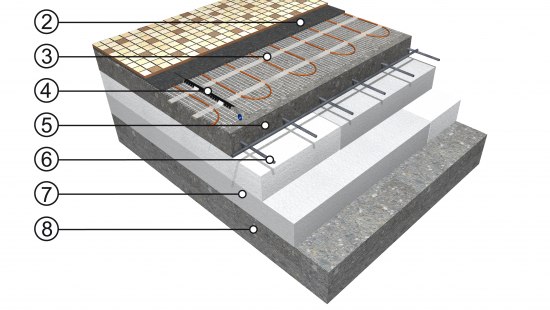Measuring the speed of floor warming

In the latter case, where another heat source (e.g. a hot-water heating device) is used to heat a room and the electric heating mat serves to make a warmer, more comfortable floor, the time for warming the floor tiles is an important variable. Because the system operates for relatively short time intervals (approximately 1–2 hours in the morning and evening), it should be able to warm the floor tiles in the shortest possible time. Heat accumulation and slow cooling of the floor is neither useful nor desirable. The warming speed can of course be influenced by the type of system, and for supplementary heating only a direct (non-accumulating) system should be used.
Even if you use a direct supplemental heating system, however, that is no guarantee that the floor will warm fast enough. The behavior of the floor depends upon its overall composition and, if the structure does not contain thermal insulation, it may take even several hours to warm the floor. This problem is particularly significant in cases of reconstruction, because no thermal insulation was usually used in older buildings. That is to say, it is difficult and very expensive to install an additional 6 cm layer of polystyrene because this would mean either to destroy some 10 cm of the floor in order to create space for insulation and the new flooring or to increase the height of the floor by 10 cm. This is often technically impossible.
Nevertheless, there exists a solution that is technically and financially practical, and that is to install additional F-Board insulation (odkaz otevøít v novém oknì) directly under the Ecofloor thermal mat. The insulation increases the thermal resistance beneath the heating mat and ensures that the heat is directed primarily into the floor tiles, rather than into the foundation structure. The insulation comes in 6 mm and 10 mm thicknesses. Using F-Boards 6 mm thick, the thickness of the entire new structure is just 2.5 cm including the heating mat and new floor tiles.
The significance of this insulation is demonstrated by means of three actual applications in which were measured the times to warm the surface of the floor tiles. In all three cases, a heating mat with output of 160 W/m2 was installed directly into the adhesive sealing cement beneath the floor tiles.
Bathroom in an apartment building
The apartment with bathroom is situated on the second floor in an apartment building in Jeseník (northern Moravia in the Czech Republic). Built in 1908, the building is of solid construction made from fully baked bricks, with the external walls 80 cm thick. The ceiling and floor structures are of similarly solid construction. The girder ceiling is covered with wooden foundation boards that are themselves covered with brick floor 4 cm thick, and there is an additional concrete layer 4 cm thick in the bathroom. The building has very good thermal accumulation characteristics and an ideal humidity microclimate.
The apartment is heated using a hot-water system. In the bathroom, the heating mat was installed under the floor tiles into the adhesive sealing cement to improve comfort by heating the floor. There is no additional insulation between the heating mat and the floor construction. Beneath the bathroom, there is another tenant’s apartment that is also heated.
As can be seen from the graph above, the time to heat the floor from 20 °C to 28 °C was 3.5 hours, and to 29 °C even 5 hours. After 5 hours of operation, the heating mat was turned off and the floor began to cool down very slowly.
The system definitely works as an accumulating system, which is caused by the 8 cm thickness of the structure (4 cm concrete, 4 cm brick foundation) beneath the heating mat. In view of the fact that it was supposed to provide only supplemental heating for increased comfort, the entire system can be regarded as essentially nonfunctional. This problem could easily have been prevented by installing additional insulation, as the following cases will indicate.
Bathroom in a family house
A client reconstructing the bathroom in his family house requested that the electrical heating mat be installed there. In this case, it would serve again as a supplemental heating source for increased comfort, as the bathroom is heated using a hot-water radiator. The bathroom is situated on the ground floor, and below it is a cold cellar that is not heated. The building is old, there is no (!) thermal insulation in the floor. The floor consists of a concrete slab 8 cm thick (2 × 4 cm) with hydro-insulation. The prepared floor was covered with CLIMAPOR-POLYPLAN thermal insulation 2 mm wide, a heating mat and new floor tiles. As can be seen from the graph above, the system works very well and the floor reached the desired temperature in just 26 minutes.
This is despite the fact that there was no thermal insulation in the floor, but there was a POLYPLAN layer 2 mm thick and an unheated room with an average temperature of 5 °C–8 °C was under the bathroom. The temperature fluctuation in the upper part of the graph (28 °C–29 °C) is caused by the thermostat, which switched the heating mat on and off when the required temperatures were reached. Moreover, the floor cools down much more quickly because the CLIMAPOR-POLYPLAN insulation avoided the unwanted accumulation of heat into the concrete floor.
Test sample with F-Board insulation
In April 2007, Fenix launched a new floor insulation under the name F-Board. It was tested for, among other things, the time needed to warm the floor. In the room used for the test, there was created a test area of a floor whose structure corresponded with that of the floor after reconstruction. That means that original floor tiles were covered with a new floor: the adhesive sealing cement was spread on the existing ceramic floor tiles (which had been laid onto a concrete foundation that was directly on bare earth and without thermal insulation), which were first covered with the F-Board insulation 6 mm thick. The came the heating mat with output of 160 W/m² and the new floor tiles.
Please note in the following graph that the temperature in the test room was only ~20 °C, as compared to the bathroom temperatures in the two cases described above. Comparing the warming time curve for the test room with the respective curve for the bathroom in the family house where the CLIMAPOR-POLYPLAN insulation was installed, the time to warm the floor from 22 °C to 28 °C was 24 minutes, which is “only” 2 minutes less. However, this was reached at a significantly lower room temperature, which is an important factor affecting the time both to cool down and, therefore, to warm the floor.
A greater thickness of the F-Board insulation allows the system to be more dynamic. Moreover, the F-Boards have other advantages compared to the CLIMAPOR-POLYPLAN insulation: as they are produced in the form of boards, they can be laid very easily. CLIMAPOR-POLYPLAN comes in rolls which show so-called “shape memory effect” of the material when being laid. That means that POLYPLAN tends to “bridge up” on the floor. Moreover, each F-Board is covered with sealing cement and hardened glass fabric on both sides. This guarantees excellent adhesiveness of the individual layers as well as the floor’s greater mechanical carrying capacity. Provided that the recommended sealing cements are used and the technological procedure is followed, F-Boards serve also as hydro-insulation, which is highly useful for reconstructions or wooden constructions.
Conclusion
To make the comparison simpler, all three types of application were combined into a single graph comparing the times to warm the floor within a span of two hours. Each application is indicated with a different color (floor temperature curves are in bold while room temperature curves are not).
In conclusion, we can definitely say that it is appropriate to use the additional insulation for systems that serve for occasional heating of floor tiles to increase comfort and that the related initial investment will be greatly repaid in the form of flexible as well as economical operation.







